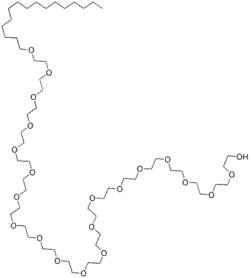 The structure of polyethylene glycol hexadecyl ether with 20 polyethylene glycol units | |
| Names | |
|---|---|
| IUPAC name
α-Hexadecyl-ω-hydroxypoly(oxyethylene) | |
| Other names
polyoxyethylene cetyl ether Brij 58 Brij 56 Brij 52 | |
| Identifiers | |
3D model (JSmol) |
|
| ChemSpider | |
| ECHA InfoCard | 100.105.524 |
| EC Number |
|
PubChem CID |
|
| UNII | |
CompTox Dashboard (EPA) |
|
| |
| |
| Hazards | |
| GHS labelling: | |
 | |
| Warning | |
| H302, H315 | |
| P264, P270, P280, P301+P312, P302+P352, P321, P330, P332+P313, P362, P501 | |
| Safety data sheet (SDS) | MSDS |
Except where otherwise noted, data are given for materials in their standard state (at 25 °C [77 °F], 100 kPa).
Infobox references | |
Cetomacrogol 1000 is the tradename for polyethylene glycol hexadecyl ether, which is nonionic surfactant produced by the ethoxylation of cetyl alcohol to give a material with the general formula HO(C2H4O)nC16H33. Several grades of this material are available depending on the level of ethoxylation performed, with repeat units (n) of polyethylene glycol varying between 2 and 20. Commercially it can be known as Brij 58 (when n=20) or Brij 56 (when n=10). Brij is a trademark of Croda International.
It is used as a solubilizer and emulsifying agent in foods, cosmetics, and pharmaceuticals, often as an ointment base. It is used as an oil in water (O/W) emulsifier for creams/lotions, and a wetting agent.
See also
- Isoceteth-20 - a similar material made using iso-cetyl alcohol
References
This article is issued from Wikipedia. The text is licensed under Creative Commons - Attribution - Sharealike. Additional terms may apply for the media files.